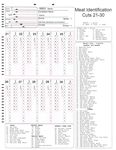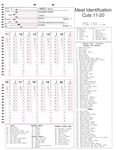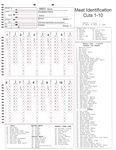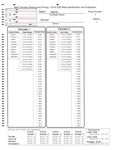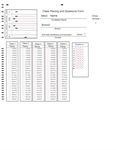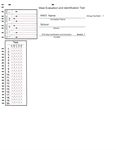Meat Evaluation & Technology - Agricultural Leadership, Education and ...
←
→
Page content transcription
If your browser does not render page correctly, please read the page content below
Meat Evaluation & Technology Nebraska Career Development Event Handbook and Rules for 2019-2024 1. EVENT PURPOSE The purpose of the Nebraska Meats Evaluation & Technology Career Development Event is to create interest and promote understanding in the meat industry by providing opportunities for recognition through the demonstration of skills and proficiencies. It also gives students an opportunity to explore career opportunities available in the meat industry and encourages students to pursue careers in the meat industry. Agriculture Education courses that align with the Meats Evaluation and Technology CDE include: Animal Science and Large Animal Management. Meat Evaluation and Technology Page 1 of 25
2. OBJECTIVES
a. Individual Objectives
I. Students will evaluate and rank classes of four of the following: beef carcasses;
wholesale cuts of beef; pork carcasses; wholesale cuts of pork; lamb carcasses;
fresh meat retail cuts (steaks, roasts or chops of fresh retail cuts of beef, pork,
or lamb); smoked or cured retail cuts (center ham slices, shank or rump portion
of ham, boneless ham, sliced bacon, fresh pork sausage, smoked sausage.)
II. Students will evaluate beef carcasses for quality and yield grades.
III. Students will observe and recall attributes that pertain to the criteria and
differences used in placing 2 classes (trimness, muscling, quality and/or sex) by
answering questions.
IV. Students will answer multiple choice questions covering one or more of the
following meat science topics: pork color; beef & pork marbling scores; beef
13th rib fat thickness evaluation; and beef ribeye area size.
V. Students will identify fresh and smoked meats for species, wholesale, and retail
cut.
b. Test Objectives
I. Answer multiple choice questions regarding the following topics: Beef quality
and yield grading; retail identification; pork carcass grading; primal cuts; pork
quality; lamb grading; meat selection, storage, cookery, nutrition, and food
safety.
3. ELIGIBILITY
a. The Meats Evaluation & Technology CDE is a non-qualifying event at the state level
b. Team make-up:
I. Team size shall be four members, all of whom must be pre-registered as
'participant' or ‘alternate’.
II. All four team members will be scored and counted towards the team total.
III. All four team members are eligible for individual awards.
4. RECOMMENDED ATTIRE
a. Closed-toed shoes are required
b. Hairnets will be provided and are required to be worn by each participant.
c. Students should wear warm clothing (be prepared to spend two hours in cold, 40˚F,
storage).
d. Official FFA Dress is NOT recommended.
e. Recommended to bring clean white gloves.
Meat Evaluation and Technology Page 2 of 255. REQUIRED SUPPLIES AND EQUIPMENT
a. Each participant will be provided blank paper, grading calculation worksheet, and scan
forms.
b. Participants should bring two clean No. 2 pencils. (No marks for measurements.)
c. Participants should bring a clean clipboard. (No marks for measurements or notes.)
d. Participants must not bring any blank paper, notes, USDA Beef Grading worksheets,
any electronic communication items, purses or backpacks.
6. EVENT SCHEDULE
a. Contestants will be allowed 10 minutes to place each of the placing classes, 10
minutes to review notes and answer the 10 questions, 10 minutes for identification of
10 retail cuts, 10 minutes for answering the 20 test questions, and 10 minutes for the
laboratory practicum questions.
7. ANNUAL THEME
There is no annual theme or topic for this CDE.
8. EVENT FORMAT
Contest. The Meats Identification Contest is composed of five (5) classes (50 points each), one
(1) set of ten (10) questions from two of the placing classes (50 points), beef carcass quality
grading, yield grading and pricing (60 points), thirty (30) retail cuts for identification(180 points),
a written test consisting of twenty (20) questions (60 points), and a laboratory practicum (10
questions, 50 points). Total points for an individual in the contest is 650, and 1950 points is
possible for each team.
a. Placing Classes. The five (5) classes (50 points each) will be selected from:
I. Rank Four Beef Carcasses
II. Rank Four Wholesale Cuts of Beef
III. Rank Four Pork Carcasses
IV. Rank Four Wholesale Cuts of Pork
V. Rank Four Lamb Carcasses
VI. Rank Four Retail Cuts; steaks, roasts or chops of fresh retail cuts of beef, pork, or
lamb.
VII. Rank Four Retail Cuts of cured, and/or smoked retail cuts.
1. cured/smoked center ham slices, shank or rump portion of ham
2. cured/smoked boneless ham
3. cured/smoked sliced bacon
4. fresh pork sausage
5. cured/smoked smoked sausage
VIII. Scores for the placing classes will be determined by using “cuts” for the top,
middle and bottom placing and compared to the official placing for the class.
1. Total of 250 points for five classes.
Meat Evaluation and Technology Page 3 of 25b. Placing Class Questions: One set of ten questions will be asked covering two of the
above placing classes. A total of ten questions covering both classes will be asked,
meaning that five questions could be used over one class and five questions could be
asked over another class. The placing classes with questions will be identified and
students will be allowed to take notes during the placing class. However, the use of
notes will not be allowed when answering questions. Each question will be worth 5
points. A total of 50 points for 10 questions.
c. Beef Carcass Quality Grading, Yield Grading and Pricing: Participants will quality
grade, yield grade and price two beef carcasses. (View Appendix 1)
I. Quality Grading: The UDSA quality grade should be determined to the nearest 1/3
of a grade (10 points for a correct answer, 8 points for a 1/3 grade deviation, 5
points for a 2/3 grade deviation, 1 point for a full grade deviation, and 0 points for
all others).
II. Yield Grading: The USDA Yield Grade will be determined to the nearest 1/3 of a
Yield grade (10 points for a correct answer, 7 points for a 1/3 grade deviation, 4
points for a 2/3 grade deviation, 1 point for a full grade deviation, and 0 points for
greater than a full grade deviation).
III. Pricing will be determined from a grid that includes quality grade, yield grade,
carcass weight and other carcass factors (10 points for a correct answer, 1 point
deduction for each $1.00 deviation from the official answer).Total of 20 points for
pricing two carcasses.
IV. Total of 60 points for quality grading, yield grading, and pricing of two carcasses
d. Retail Cut Identification: Thirty (30) retail cuts of meat to be identified. Contestants will
identify the retail cut species name (1 point), the wholesale or primal name (2 points)
and the retail cut name (3 points) for a total of 6 points per retail cut. Total of 180 points
for 30 retail cuts. (View Appendix 2,3,4, 5, and 6)
e. Written Test: A written test of 20 questions relating to meat selection, storage,
cookery, nutrition, and food safety will be given. Each question will be valued at 3
points. Total of 60 points for 20 questions. (View Appendix 7)
f. Laboratory Practicum: A laboratory practicum will cover one of the following meat
science topics: meat color, marbling scores, fat thickness evaluation, and ribeye area
(beef) evaluation. The answers will be multiple choice and will be based on scales for
marbling scores, color scores, fat thickness by tenths of inches and Preliminary Yield
Grade (PYG), and ribeye area by 1.0 square inches. Each correct answer is 5 points,
one deviation from the correct answer will be worth 3 points, and all deviations greater
than 1 deviation will be worth 0 points. Total of 50 points for 10 questions.
Talking or communicating with others is forbidden. Infractions of this rule, may result in an
individual participant or team being disqualified.
Meat Evaluation and Technology Page 4 of 259. SCORING
Event Individual Points
• Classes (5 Classes x 50 Points) 250
• Class Questions (10 Questions x 5 Points) 50
• Quality/Yield (2 Carcasses x 3 Components x 10 Points) 60
Grading
• Retail Identification (30 Retail Cuts x 6 Points) 180
• Written Test (20 Questions x 3 Points) 60
• Lab Practicum (10 Samples x 5 Points) 50
Total score 650
Team Scoring
• Individual Scores (650 Possible Points x 4 Individuals) 2600
For an example scantron, view appendix 8.
10. TIEBREAKER
Meat Evaluation and Technology Page 5 of 25a. Individual
I. Retail Identification Score
II. Grading Score
III. Class Questions Score
b. Team
I. Retail Identification total score of the team
II. Grading total score of the team
III. Class Questions total score of the team
11. RESOURCE MATERIALS
a. General Resources
I. Learning lessons, aids, and pictures from previous contests can be found at:
https://go.unl.edu/paseandcdemeatscontest
b. Identification of retail cuts.
I. Retail meat cuts will be identified according to the "Uniform Retail Meat Identity
Standards" on the web at: https://go.unl.edu/retailcutsid
II. “The Guide to Identifying Meat Cuts” can be used for student training and is
available from the American Meat Science Association, 111 North Dunlap
Avenue, Savoy, IL 61874, www.meatscience.org. Ph 217-356-3182.
c. Placing Classes
I. The “Meat Evaluation Handbook” will be used as the guide for the placing
classes. The book is available from the American Meat Science Association, 111
North Dunlap Avenue, Savoy, IL 61874, www.meatscience.org (Also see PDF,
Appendix 1)
II. Study guides for cured/smoked and processed meats will be developed
d. Beef Grading and Pricing
I. Beef carcass grading will be applied according to USDA standards described
the publication “Agricultural Marketing Service, United States Standards for
Grades of Carcass Beef” which can be found at:
https://go.unl.edu/usdabeefgradingstandards
II. The North Central Regional Extension Publication #357 “Quality and Yield
Grades for Beef Carcasses” is sold on Amazon and is also available at: available
at: http://digitalcommons.unl.edu/extensionhist/358
III. Beef pricing will be based on a pricing grid for Yield and Quality grades with
adjustments for other carcass factors. An example is given in the table below:
Meat Evaluation and Technology Page 6 of 25HCW = Hot Carcass Weight
Pricing scoring is 10 points for a correct answer and 1 point deduction for each $1.00
deviation from the official answer, and 0 points for any answer with a $10.00 deviation
or greater from the official answer.
IV. The laboratory practicum will cover one of the following meat science topics:
meat color, marbling scores, fat thickness evaluation, and ribeye area (beef)
evaluation and an information fact sheet for the topic will be posted at:
https://animalscience.unl.edu/pase-and-cde-meats-contest
V. The test will cover meat science topics related to the contest and an example
will be posted at: https://animalscience.unl.edu/pase-and-cde-meats-contest
12. PAST EXAMS
a. View Resource Materials
13. POST-CDE DEBRIEFING OPPORTUNITY
a. The Meats Lab will be open immediately following the completion of the CDE for
coaches and students to debrief and to take pictures or video of the entire
competition (with the approval and consent of coordinators).
Meat Evaluation and Technology Page 7 of 25Appendix Meat Evaluation and Technology Page 8 of 25
Appendix 1: Beef Carcass Quality & Yield Grading
Training Form for Quality Grading and Yield Grading of Beef Carcasses
Carcass PYG Hot REA REA % KPH Yield
Number Carcass Required Grade
Est. Adj. Weight Est. Adj. Est. Adj.
1.
2.
Yield Grade 1 Yield Grad 2 Yield Grade 3 Yield Grade 4 Yield
Grade 5
High = 1.0-1.3 High = 2.0-2.3 High = 3.0-3.3 High = 4.0-4.3 High =
5.0-5.3
Avg. = 1.4-1.6 Avg. = 2.4-2.6 Avg. = 3.4-3.6 Avg. = 4.4-4.6 Avg. =
5.4-5.6
Low = 1.7-1.9 Low = 2.7-2.9 Low = 3.7-3.9 Low = 4.7-4.9 Low =
5.7-5.9
Place the Yield grade and corresponding letter (H=High, A= Average, L=Low) in the
Yield Grade Column. Ten points are allowed for the correct grade on each carcass, 7
points for a 1/3 grade deviation, 4 points for a 2/3 grade deviation, 1 point for a full
grade deviation, and 0 points for greater than a full grade deviation.
Carcass Number Maturity Marbling Quality Grade
1.
2.
Prime High = Pr + Choice High = Ch+ Select High = Se + Standard High =St+
Prime Avg. = Pr o Choice Avg. = Ch o
Prime Low = Pr - Choice Low = Ch - Select Low = Se - Standard Low = St -
Commercial, Utility, Canner and Cutter grades will not be used in the contest.
Place the grade in the column for quality grade. Ten points are allowed for the correct
grade on each carcass, 8 points for a one-third grade deviation, 5 points for two-thirds
grade deviation, 2 points for one full grade deviation, 0 points for all others.
Carcass Quality Grade Yield Grade Discounts Price/cwt
Number
1.
2.
Determine the carcass price per cwt based on the grid provided
Meat Evaluation and Technology Page 9 of 25Appendix 2: Beef Retail Cuts
Retail
Primal Retail Cut Species Primal Cut
Brisket Corned B B 89
Brisket Flat Half, Bnls B B 15
Brisket Whole, Bnls B B 10
Chuck 7-bone Pot-Roast B C 26
Chuck Arm Pot-Roast B C 03
Chuck Arm Pot-Roast, Bnls B C 04
Chuck Blade Roast B C 06
Chuck Eye Roast, Bnls B C 13
Chuck Eye Steak, Bnls B C 45
Chuck Mock Tender Roast B C 20
Chuck Mock Tender Steak B C 48
Chuck Petite Tender B C 21
Chuck Shoulder Pot Roast (Bnls) B C 29
Chuck Top Blade Steak (Flat Iron) B C 58
Flank Flank Steak B D 47
Loin Porterhouse Steak B F 49
Loin T-bone Steak B F 55
Loin Tenderloin Roast B F 34
Loin Tenderloin Steak B F 56
Loin Top Loin Steak B F 59
Loin Top Loin Steak, Bnls B F 60
Loin Top Sirloin Cap Steak, Bnls B F 64
Loin Top Sirloin Steak, Bnls Cap Off B F 63
Loin Top Sirloin Steak, Bnls B F 62
Loin Tri Tip Roast B F 40
Plate Short Ribs B G 28
Plate Skirt Steak, Bnls B G 54
Rib Rib Roast B H 22
Rib Ribeye Roast, Bnls B H 13
Rib Ribeye Steak, Bnls B H 45
Rib Ribeye Steak, Lip-On B H 50
Round Bottom Round Roast B I 08
Round Bottom Round Rump Roast B I 09
Round Bottom Round Steak B I 43
Round Eye Round Roast B I 14
Round Eye Round Steak B I 46
Round Round Steak B I 51
Round Round Steak, Bnls B I 52
Round Tip Roast - Cap Off B I 36
Round Tip Steak - Cap Off B I 57
Round Top Round Roast B I 39
Round Top Round Steak B I 61
Various Beef for Stew B N 82
Various Cubed Steak B N 83
Various Ground Beef B N 84
Meat Evaluation and Technology Page 10 of 25Appendix 3: Pork Retail Cuts
Retail
Primal Retail Cut Species Primal Cut
Ham/Leg Pork Fresh Ham Center Slice P E 44
Ham/Leg Pork Fresh Ham Rump Portion P E 25
Ham/Leg Pork Fresh Ham Shank Portion P E 27
Ham/Leg Smoked Ham, Bnls P E 91
Ham/Leg Smoked Ham, Center Slice P E 90
Ham/Leg Smoked Ham, Rump Portion P E 96
Ham/Leg Smoked Ham, Shank Portion P E 97
Ham/Leg Tip Roast, Bnls P E 35
Ham/Leg Top Roast, Bnls P E 38
Loin Back Ribs P F 05
Loin Blade Chops P F 66
Loin Blade Chops, Bnls P F 67
Loin Blade Roast P F 06
Loin Butterflied Chops Bnls P F 68
Loin Center Loin Roast P F 11
Loin Center Rib Roast P F 12
Loin Loin Chops P F 70
Loin Rib Chops P F 71
Loin Sirloin Chops P F 73
Loin Sirloin Cutlets P F 53
Loin Sirloin Roast P F 30
Loin Smoked Pork Loin Chop P F 93
Loin Smoked Pork Loin Rib Chop P F 95
Loin Tenderloin, Whole P F 34
Loin Top Loin Chops P F 74
Loin Top Loin Chops, Bnls P F 75
Loin Top Loin Roast, Bnls P F 37
Shoulder Arm Picnic, Whole P J 02
Shoulder Arm Roast P J 03
Shoulder Arm Steak P J 41
Shoulder Blade Boston Roast P J 07
Shoulder Blade Steak P J 42
Shoulder Smoked Picnic, Whole P J 94
Side Slab Bacon P K 98
Side Sliced Bacon P K 99
Side/Belly Fresh Side P K 17
Spareribs Pork Spareribs P L 32
Various Country Style Ribs P N 69
Various Ground Pork P N 85
Various Hock P N 86
Various Pork Cubed Steak P N 83
Various Pork Sausage Links P N 87
Various Sausage P N 87
Various Smoked Pork Hock P N 92
Meat Evaluation and Technology Page 11 of 25Appendix 4: Lamb Retail Cuts
Retail
Primal Retail Cut Species Primal Cut
Breast Ribs (Denver Style) L A 24
Leg American Style Roast L E 01
Leg Center Slice L E 44
Leg Frenched Style Roast L E 16
Leg Leg Roast, Bnls L E 18
Leg Sirloin Chops L E 73
Leg Sirloin Half L E 31
Loin Loin Chops L F 70
Loin Loin Roast L F 19
Rib Rib Chops L H 71
Rib Rib Chops Frenched L H 72
Rib Rib Roast L H 22
Rib Rib Roast, Frenched L H 23
Shoulder Arm Chops L J 65
Shoulder Blade Chops L J 66
Shoulder Square Cut L J 33
Various Shank L N 88
Meat Evaluation and Technology Page 12 of 25Appendix 5: Variety Retail Cuts
Retail
Species Primal Retail Cut Species Primal Cut
Beef Variety Heart B M 76
Lamb Variety Heart L M 76
Pork Variety Heart P M 76
Beef Variety Kidney B M 77
Lamb Variety Kidney L M 77
Pork Variety Kidney P M 77
Beef Variety Liver B M 78
Lamb Variety Liver L M 78
Pork Variety Liver P M 78
Beef Variety Oxtail B M 79
Beef Variety Tongue B M 80
Lamb Variety Tongue L M 80
Pork Variety Tongue P M 80
Beef Variety Tripe B M 81
Meat Evaluation and Technology Page 13 of 25Appendix 6: Retail Cuts Code Sheet
Retail Cuts Code Sheet Practice Meat Identification Card
SPECIES - 1 Point
B- Beef P- Pork L- Lamb
Name:____________________________
PRIMAL CUTS- 2 Points
A. Breast F. Loin K. Side
B. Brisket G. Plate (Belly) Cut # Species Primal Retail Score
C. Chuck H. Rib or Rack L. Spareribs Cut Cut
D. Flank I. Round M. Variety
E. Ham or J. Shoulder Meats
1.
Leg N. Various
Meats
2.
RETAIL CUTS - 3 points
3.
Roasts/ Pot Roasts Steaks Variety Meats
1. American Style 41. Arm Steak 76. Heart
4.
2. Arm Picnic 42. Blade Steak 77. Kidney
3. Arm Roast 43. Bottom Round 78. Liver
5.
4. Arm Roast Steak 79. Oxtail
(Bnls) 44. Center Slice 80. Tongue
6.
5. Back Ribs 45. Eye Steak (Bnls) 81. Tripe
6. Blade Roast 46. Eye Round Steak
7.
7. Blade Boston 47. Flank Steak Various Meats
8. Bottom Round 48. Mock Tender 82. Beef for
8.
Roast (Bnls) Steak Stew
9. Bottom Round 49. Porterhouse Steak 83. Cubed Steak 9.
Rump Roast 50. Ribeye, Lip-on 84. Ground Beef
(Bnls) Steak, bone in 85. Ground Pork 10.
10. Brisket, Whole 51. Round Steak 86. Hocks
(Bnls) 52. Round Steak 87. Sausage 11.
11. Center Loin (Bnls) Link/Pattie
Roast 53. Sirloin Cutlets 88. Shank 12.
12. Center Rib Roast 54. Skirt Steak (Bnls)
13. Eye Roast (Bnls) 55. T-Bone Steak Smoked/Cured 13.
14. Eye Round Roast 56. Tenderloin Steak 89. Brisket,
15. Flat Half (Bnls) 57. Tip, Cap Off Corned 14.
16. Frenched Style Steak 90. Center Slice
17. Fresh Side 58. Top Blade (Bnls) 91. Ham (Bnls) 15.
18. Leg Roast (Bnls) Flat Iron Steak 92. Hocks
19. Loin Roast 59. Top Loin Steak 93. Loin Chop 16.
20. Mock Tender 60. Top Loin (Bnls) 94. Picnic
Roast Steak (Whole) 17.
21. Petite Tender 61. Top Round Steak 95. Rib Chop
22. Rib Roast 62. Top Sirloin Steak 96. Rump 18.
23. Rib Roast (Bnls) Portion
(Frenched) 63. Top Sirloin Cap 97. Shank 19.
24. Ribs (Denver Off Steak (Bnls) Portion
Style) 64. Top Sirloin Cap 98. Slab Bacon 20.
25. Rump Portion Steak (Bnls) 99. Sliced Bacon
26. Seven (7) Bone 21.
Roast Chops
27. Shank Portion 65. Arm Chop 22.
28. Short Ribs 66. Blade Chop
29. Shoulder Roast 67. Blade Chop 23.
(Bnls) (Bnls)
30. Sirloin Roast 68. Butterflied Chop 24.
31. Sirloin Half (Bnls)
32. Spareribs 69. Country Style 25.
33. Square Cut Ribs
(Whole) 70. Loin Chop 26.
34. Tenderloin 71. Rib Chop
(Whole) 72. Rib Chop 27.
35. Tip Roast (Bnls) (Frenched)
36. Tip, Cap Off 73. Sirloin Chop 28.
Roast (Bnls) 74. Top Loin Chop
37. Top Loin Roast 75. Top Loin Chop 29.
(Bnls) (Bnls)
38. Top Roast (Bnls) 30.
39. Top Round
Roast
40. Tri-Tip Roast
Meat Evaluation and Technology Page 14 of 25Appendix 7: Written Test
CDE MEATS Contest - WRITTEN TEST – 2018
1. The Beef Chuck Flat Iron Steak :
A. Was researched and developed at the University of Nevada.
B. Is a steak that normally is served in 12-16 ounce portions.
C. Is a steak cut from the Beef Shoulder Top Blade Roast.
D. Is a single muscle cut consisting of portions from the Supraspinatus muscle.
E. All of the above are correct.
2. The flecks of fat visible from the cut surface of a muscle that is cut across the grain
of the muscle is called:
A. Maturity
B. Marbling
C. External fat
D. Intramuscular fat
E. Seam fat
3. The major difference between the beef quality grades U.S. Choice and U.S. Prime
is:
A. Maturity
B. Nutrition
C. Marbling
D. Lean color
E. None of the above are correct
4. The USDA Grade that indicates the amount of boneless closely trimmed retail cuts
in a carcass is:
A. Quality grade
B. Yield Grade
C. Dressing Percentage
D. Cooler Shrinkage
E. Cutability
5. The USDA Yield Grades for young beef in the “B” maturity are:
A. 1,2,3,4,5
B. 1,2,3,4, Utility
C. 1,2,3, No Roll
D. Prime, Choice, Select, Standard
E. Prime, Choice, Standard
Meat Evaluation and Technology Page 15 of 256. The factors used to predict the USDA yield grades of beef carcasses are:
A. Hot carcass weight, last rib backfat and muscle score.
B. Hot carcass weight, loin muscle area and Kidney Heart and Pelvic fat.
C. Hot carcass weight, adjusted fat thickness and muscle score.
D. Hot carcass weight, adjusted fat thickness, rib eye area and kidney pelvic and
heart fat percentage.
E. Backfat, PYG and Adj. PYG
7. The factor used to calculate the USDA Yield grades for lamb is:
A. Hot carcass weight
B. Fat streaking in the flank.
C. Maturity.
D. Fat thickness.
E. Body wall thickness
8. The factors used for USDA grading of pork carcasses are:
A. Last rib backfat at the midline and muscle score
B. Last rib backfat at the midline and loin muscle area at the 10th rib
C. 10th rib backfat over the loin muscle and muscle score
D. 10th rib backfat over the loin muscle and loin muscle area
E. Lean color and marbling
9. The muscling scores used for pork carcass grading are:
A. Abundant, Modest, and Slight
B. Thick, Average, and Thin
C. Thick, Modest and Thin
D. Very Thick, Thick and Thin
E. Modest, Average and Very thin.
10. A Yield Grade 4 beef carcass that has an 850 lb hot carcass weight as compared
to a Yield Grade 2 carcass that is also an 850 lb hot carcass weight would be
expected to have:
A. More backfat
B. A larger ribeye for the same weight of carcass
C. More marbling
D. Both A and B are correct
E. All of the above answers are correct
11. The higher value steak cuts of beef usually come from the:
A. Round and Chuck
B. Rib and Loin
C. Chuck and Loin
D. Rib and Round
E. Shank and Rib
Meat Evaluation and Technology Page 16 of 2512. The Primal cuts of lamb are:
A. Leg, loin, rack (or rib), shoulder, breast, and foreshank
B. Round, loin, rack (or rib), shoulder, brisket, shank, plate and flank
C. Round, loin, rib, chuck, brisket, shank, plate and flank
D. Ham, loin, boston shoulder, picnic shoulder, belly, spareribs, neckbones and
jowl.
E. Round, Loin, Belly and Shoulder.
13. A Lamb Sirloin Chop Retail cut that is “Frenched” is a:
A. Lamb Rib Chop that was raised and processed in the southern part of France
B. Lamb Rib Chop that has the surface fat trimmed over the lower rib
C. Lamb Rib that has the chine bone removed to allow a knife to cut between the
ribs
D. Lamb Rib Chop that has all the muscle and fat tissue removed from the lower
part of the rib bone.
E. Lamb Rib Chop that has been marinated in French wine.
14. The Loin Muscle Area used for calculation of percentage lean in a pork carcass is a
measurement of the longissimus muscle exposed by ribbing the pork carcass at
the:
A. Last rib
B. First rib
C. 10th rib
D. 12th rib
E. 14th rib
15. The Beef Carcass ribeye measurement used for the calculation of USDA Yield
Grade is taken at the:
A. Last rib
B. First rib
C. Last Lumbar
D. 10th rib
E. 12th rib
16. A fresh pork ham that has a light to gray lean color, a pH of 5.2 and a lean surface
that wet, soft and drips is known as:
A. DFD, Dark Firm and Dry
B. RSE, Red, Soft, and Exudative
C. PSE, Pale, Soft, and Exudative
D. PDT, Porcine Dark Tissue
E. SGP, Standard Grade Pork
Meat Evaluation and Technology Page 17 of 2517. A grid for measuring the area (square inches) of a beef ribeye has:
A. 100 dots per square inch
B. 20 dots per square inch
C. 10 dots per square inch
D. 5 dots per square inch
E. 1 dot per square inch
18. A beef carcass with an adjusted fat thickness of 0.4 inches would have a
preliminary yield grade of:
A. 2.0
B. 2.5
C. 3.0
D. 3.5
E. 4.0
19. A beef carcass with a hot carcass weight of 900 pounds would be expected to
have the following ribeye area for Yield Grade calculation purposes.
A. 11.0
B. 12.2
C. 13.4
D. 14.6
E. 15.8
20. The seven basic cuts for retail identification include
A. Arm, Blade, Rib, Loin, Sirloin, Leg, and Brisket or Breast Cuts.
B. Neck, Blade, Rib, Loin, Round, Hock, and Flank or Belly
C. Shank, 7-bone, Loin, Leg, Spareribs, Flank or Belly
D. Arm, Neck, Rib, Loin, Sirloin, Round, Belly or Flank
E. Arm Muscle, Eye Muscle, Sirloin Muscle, Leg Muscle, Flank or Belly
Meat Evaluation and Technology Page 18 of 25Appendix 8: Example Scantron Meat Evaluation & Technology CDE Page 19 of 25
Meat Evaluation & Technology CDE Page 20 of 25
Meat Evaluation & Technology CDE Page 21 of 25
Meat Evaluation & Technology CDE Page 22 of 25
Meat Evaluation & Technology CDE Page 23 of 25
Meat Evaluation & Technology CDE Page 24 of 25
Meat Evaluation & Technology CDE Page 25 of 25
You can also read
